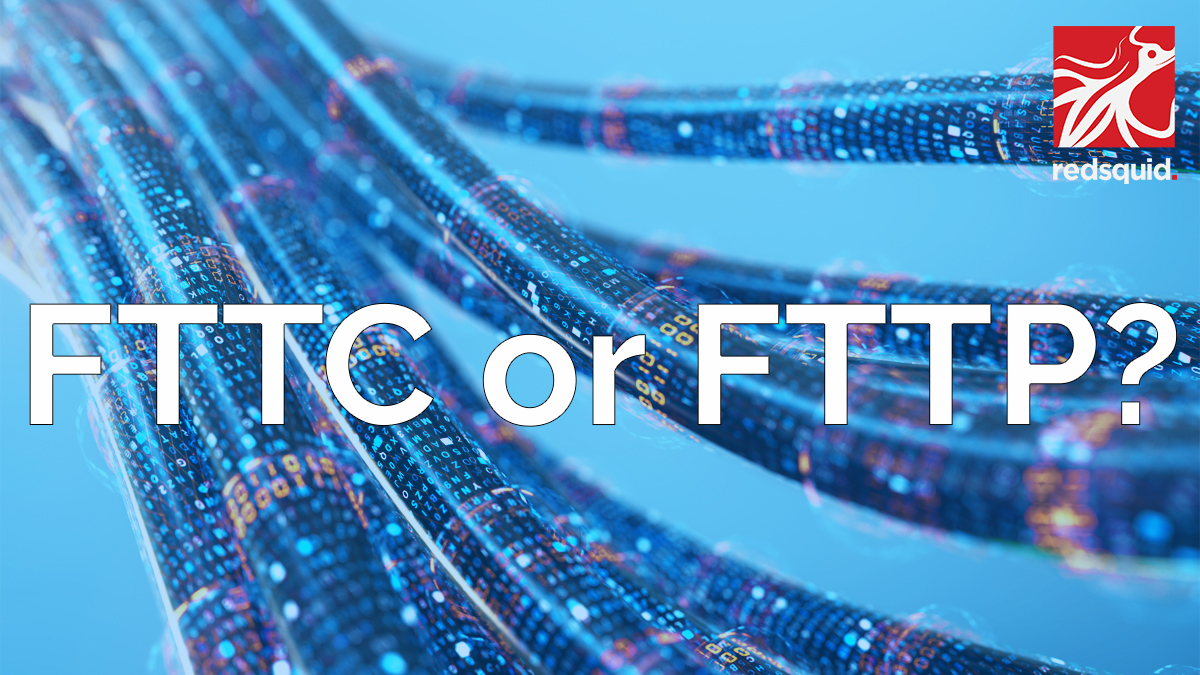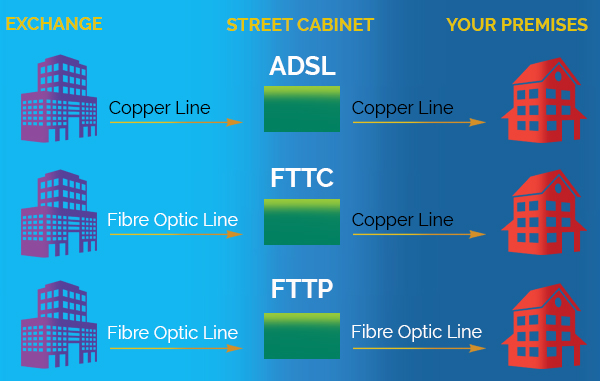What is the difference between FTTC and FTTP?
Have you been pulling your hair out in frustration over slow internet lately? And does it seem like your connectivity has only become worse during the last year? If so, you are experiencing the same, as so many others at the moment. The demand for connectivity has boomed during the last year, as we all became fully reliant on being digital overnight. We are more online than ever, and as Teams meetings, VoIP calls and data in the Cloud only continues to rise, good and reliant connectivity is the biggest priority for many businesses.
But what exactly is FTTC and FTTP? What is the difference? And how can it help your business, as we now are on the way back to our offices?

What is FTTP?
FTTP (Fibre to the Premises) describes the direct line of fibre delivered straight to your premises. It is an advanced fibre optic cable, that delivers the internet access directly from an Internet Service Provider (ISP). The fibre cables run all the way from your local exchange, to the premises of your business, and has fully replaced the older copper based broadband connections, also known as ADSL lines. Compared to the old ADSL lines, FTTP is super-fast broadband, delivered straight to your business.
How does FTTP work?
FTTP can deliver such high quality of connectivity, by connecting both the exchange and the premises with pure fibre optic cables. Whereas the ADSL lines used a cobber cable for the last bit up to the premises.
Now, what does that mean?
Because FTTP use fibre only, it is much more reliable, and the pure fibre optic cable can carry and deliver the data at much faster speeds. With the width of a human hair, the fibre optic cables are designed to carry light (literally).
It can do that because the casing around the inside of the fibres are 100% reflective, so the light can bounce of the side and travel on the cables. At the end of the cable the lights flashes will then be recognised as data.
How will it make a difference to your business?
The next generation speed makes FTTP ideal for businesses, as it can deliver your day to day operations such as voice and video meetings at speeds reaching up to an impressive 1Gbps (gigabit per second)!
Now THAT is seriously fast!
Pros and Cons of FTTP?
Because the speed and performance of FTTP is unaffected of both the distance to the exchange and by demand, it will give you a more reliable connection with faster speeds whenever you need and use it. FTTP is built and designed to being expanded and it has the possibility to grow with your business, so you can upscale in the future as the needs of your business change.
FTTP is the more expensive solution because installation is a bigger job. To install FTTP, the provider will have to dig up roads to lay new cables. Although FTTP is being spread out across the UK at rapid speed, it is still only available to some parts of the country, so you will still have to check the availability in your area, which your connectivity provider can do for you.

What is FTTC?
FTTC (Fibre to the Cabinet) uses a combination of both copper and fibre optic cables. For FTTC the fibre optic cables are used all the way up to the street cabinet (the green ones you will see in many streets). From the street cabinet a copper line is then connected to a cabinet on your premises.
FTTC can make use of the existing cabinets on the streets, and therefore avoids the need of having to dig up roads- hence the less expensive price.
How does FTTC work?
The business owner will receive a router from their internet service provider (ISP). After being installed this router will receive the broadband to the business.
Pros and Cons of FTTC?
90% of the premises in the UK currently have availability of FTTC, so most likely you can get it too. While it is a cheaper solution than FTTP, it will also deliver you a slower speed.
FTTC’s top speeds usually go up to 80 Mbps for download and 20 Mbps for uploads. This makes FTTC a great improvement for home internet, but in the long haul it is not necessarily a solution built for businesses. That being said, even though FTTC is slower than FTTP, it is still properly fast and definitely faster than the ADSL lines that many businesses rely on now.
How do I know which connectivity solution to choose?
The more fibre there is built into your connection the better and more reliable connectivity you will receive. Depending on the size and location of your business you will need to decide how reliant you are on your internet, and how much downtime your business can afford. The more employees, VoIP solutions and Teams meeting you have, the more connectivity you will need for your business.
And while they are both better options than the old ADSL lines, FTTP is the only one that can deliver you guaranteed performance.
Now that you know the difference between FTTC and FTTP, we can check which solution and speed you have available in your area. Just fill out the form below and we will be in touch with a solution to provide your business with the best connectivity available.
Let's check availability in your area
Fill out the form below, and we will be in touch shortly with the best solution for your business.
Let's check availability in your area
Fill out the form below, and we will be in touch shortly with the best solution for your business.
Want to share it with your friends?
